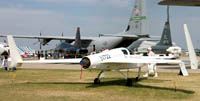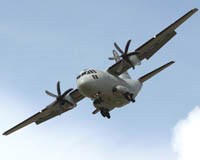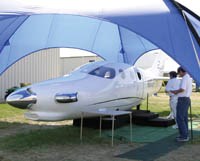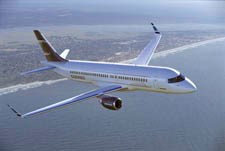Farnborough, Oshkosh Airshows showcase composites
Aircraft showcases on both sides of the Atlantic spotlight continuing growth.
Schedule two major airshows within the span of a single month, and what do you get? This year, in August, the composites industry got a healthy dose of positive exposure on two continents, as aircraft builders and aviation aficionados from around the globe gathered for Farnborough International in the U.K. and the Experimental Aircraft Assn. (EAA) AirVenture fly-in convention in Oshkosh, Wis., U.S.A.
Fanfare at Farnborough
Farnborough, one of the world's largest airshows, took place July 19-25 at Farnborough, U.K., reflecting a time of growth and development in the aircraft industry. Show organizers, the Society of British Aerospace Companies (the U.K.'s aerospace industry trade association) reported that airline orders and defense spending announcements proliferated during the event, with a reported $20 billion (USD) of business conducted during the week-long event. Show exhibitors increased in number to 1,360, up from the previous high of 1,240. The 243,000 visitors that attended the 2004 show included 42 official military delegations.
This year was the first time that materials technology has had such a high profile at Farnborough: Major aircraft programs, all of which are pushing the use of composites to create a competitive advantage, took center stage. Aircraft giants The Boeing Co. (Chicago, Ill., U.S.A.) and rival Airbus Industrie (Toulouse, France) showcased their divergent approaches to materials development as a means to differentiate their products. Beyond these high-profile programs, many UAV and winged munitions ventures were well represented -- programs for which composites are the automatic material of choice. In addition, myriad small- to medium-sized composite aircraft also were on hand.
In the spotlight: Airbus A380
Airbus presented the new technologies being used on its in-process A380, the 555-passenger jumbo commercial jet that, when built, will be the world's largest. The company emphasized the steps it has taken to mature each technology to a stage where it represents no risk to customers. Juergen Klenner, senior VP of structures in engineering at Airbus, predicted that the optimum aircraft would be made from the whole range of current metallic, composite and fiber metal laminates (FMLs), such as GLARE. While Airbus believes composite are suitable materials for fuselage fabrication, it intends to use them (for now) only in the areas where there are high loads and damage tolerance is not an issue, such as the rear fuselage. The latter is an area subject to high load inputs from the vertical and horizontal stabilizers, but its outer surfaces are out of range of airport vehicles and bird strikes. For the main fuselage, Airbus contends that a mixture of FMLs and aluminum yields the optimum overall performance, each material used in the areas that take best advantage of its individual performance properties. For instance, FMLs are used on the top and sides of the fuselage where the need to minimize crack growth and damage risk are the principle design drivers.
In a very intriguing move, Airbus revealed that it is working on more advanced forms of FML designed to enhance stiffness, but declined to provide any details.
Airbus spotlighted several new areas where its engineers see composites as having major benefits, including the pressure bulkhead (now entering service on the A340 500/600) and the center wing box and wing ribs (to be introduced for the first time on the A380). In the future, Airbus plans to extend composites use to the main wing structure, as well. The first such application will be on the A400M, the company's proposed large military transport aircraft, for which the composite wing is now being designed at the Airbus facility in Filton, U.K.
Airbus reported that its initial A380 is currently undergoing assembly in Toulouse, and is scheduled for first flight in early 2005. According to the company, the plane has been powered up successfully in an electrical test. Hydraulic and engine power-up tests will follow later this year. Some published reports hint that Airbus may modify its A330-200 model (i.e., by installing more fuel-efficient engines and, possibly, redesigning its wings) to compete head to head with Boeing's 7E7.
Off the drawing board: Boeing's 7E7
Boeing senior VP Mike Bair announced that extensive progress has been made on the design, materials selection and contractual arrangements for fabrication of its super-efficient 7E7, a 225-seat, mid-sized aircraft for which, to date, 62 total orders have been received from 24 airlines. European customers include Blue Panorama of Italy and the U.K.'s First Choice Airways, which have placed orders for four and six planes, respectively. European suppliers are heavily involved in the 7E7's development and production, including France's Labinal, Dassault Systemes, Messier-Dowty and Lacecoere, among others.
Boeing also unveiled a new current market outlook report that predicts strong growth in the air freighter fleet. According to the report, 724 new production freighter aircraft will enter the world fleet, with a collective value of $139 billion (USD), by the year 2023. More than half of these will be widebody planes, including Boeing's 747 and 767 aircraft.
Composites on display
Bombardier (Montreal, Canada) announced it will enter the market for large regional aircraft with a new aircraft family, the CSeries. Targeted airlines are those operating in the lower end of the 100- to 150-passenger market, an arena that, according Bombardier, is not well served by existing aircraft. Gary Scott, president of the company's new commercial aircraft program, estimates that the market is $250 billion (USD) or 6,000 aircraft over the next 20 years. The company also claims that its new CSeries will have 15 percent lower operating costs than current production regional aircraft and can be configured for transcontinental service.
GKN Plc (London, U.K.) promoted its latest achievements in composites, including a contract award for composite spars on the Airbus A400M. GKN also reiterated its recent announcement of government support for the company's "Advanced Composites Facility" on the Isle of Wight, U.K. RTM, once the select specialty of GKN in the U.S., is now being undertaken by GKN in Munich, Germany, as well. On display at the show was the German facility's first independent composite program part, a Taurus 350 stand-off weapon wing, over 1m/4 ft long, with an integrated metallic root hinge fitting.
HITCO Carbon Composites (Gardena, Calif., U.S.A.) celebrated its success in breaking into the European market, showing the seven large ribs (approximately 3m by 1m/10 ft by 3.5 ft) that it manufactures for the Airbus A380 tailplane (see March 2004HPC, p. 52). These challenging strut parts are now in production at lower weight than Airbus' original weight goal. BJ Schramm, HITCO's chief operating officer, reported that rib production has scaled up to meet Airbus' production schedule.
Hexcel (Dublin, Calif., U.S.A.) had a number of composites parts on display, including structural components for the A380 tailplane, which is assembled at the Airbus plant in Stade, Germany. Also on revue was the outer panel of a very large engine inlet barrel made by the Goodrich Aerostructures Group (Chula Vista, Calif., U.S.A.), using resin infusion methods and HexPly M36 and NC2, a non-crimp fabric.
An unprecedented number of other composite parts were highlighted on many of the other stands, in a show of force not seen at Farnborough in previous years. "Composites" has become a sexy sales feature in the aircraft industry -- long may it last!
OSHKOSH
Popularly known as the "Oshkosh Fly-in," the Experimental Aircraft Assn.'s 52nd annual EAA AirVenture fly-in convention, held this year July 27 though August 2 posted a near-record 802 commercial exhibitors (record: 807 in 2003). Although the airshow's organizers estimated a 10 to 12 percent decrease in attendance, compared to the record-setting 770,000 figure for the 2003 event, citing poor weather conditions and economic factors for the decline, more than 10,000 airplanes including nearly 2,500 showplanes) touched down in Oshkosh from North America, Europe, South America, and as far away as Africa and Australia. Officials from the U.S. Federal Aviation Admin. (FAA), the National Aeronautics and Space Admin. (NASA) and the National Transportation Safety Board (NTSB) rubbed shoulders with actor Harrison Ford, aviation icon Burt Rutan and his SpaceShip
One pilot Mike Melvill and more than 620,000 other experimental plane enthusiasts.
Light-sport aircraft
A highlight of this year's event, dubbed the "Next Century of Flight," was the introduction of a much-anticipated set of regulations that should open the world of recreational flight to many more people. FAA administrator Marion Blakey spent two days at Oshkosh, emphasizing the new opportunities available in the Light-Sport Aircraft (LSA) category, in which neither planes nor pilots are subject to rigid certification processes (see May 2003HPC, p. 53).
The LSA is the result of a chain of events that began three decades ago, when a strange apparition zoomed in low over Wittman Field for the Oshkosh Fly-in, setting the whole flight line immediately abuzz: It was Burt Rutan's latest design, a kit plane called the Vari-Eze. The debut of this unusual composite craft, which could be constructed by anyone of average skill, touched off an explosion of activity in the homebuilt aircraft arena. In 1980, the Glasair made its debut, its most notable feature (at the time) being that it came in a premolded kit form. This was quickly followed by the Lancair series, using an epoxy matrix rather than the Glasair's vinyl ester, as well as autoclave-cured, graphite/epoxy spar caps. Since then, a plethora of composite designs has come on the scene, ranging from ultralights to personal "rocketships" capable of 300 mph and more.
For the last several years, EAA, in conjunction with FAA and ASTM, have been promoting the new rules. LSA- class aircraft must be built within restrictive guidelines (e.g., maximum gross takeoff weight of 599 kg/1,320 lb, maximum level air speed of 45 knots/138 mph, daylight flight only, two or fewer occupants, unpressurized cabin, single, non-turbo prop engine). But there is plenty of latitude for a designer to work with, and the product may be packaged as a set of plans, a materials kit, a partially completed kit or a ready-to-fly aircraft.
Anticipating LSA, designers turned out existing aircraft that automatically fit the new rules, including Piper's venerable J-3 Cub. In Europe, several designs already fit, and a crowd of new ones are taking shape.
LSAs on display
From Pipistril USA, two Australian entries typified the "motorglider" portion of the LSA spectrum. As the name suggests, these aircraft have limited soaring capability (when compared with pure sailplanes), but can self-launch and their engines can be turned off from time to time in order to coast partway to the destination.
Sportair USA (Little Rock, Ark., U.S.A.), had a pair of aircraft in the sportplane category, the Star Sport and the Sting Sport. Outwardly, they appear identical, but the former is all fiberglass while the latter is constructed with carbon composites.
The Twister, imported from Germany by Pacific Aero Sport (Seattle, Wash, U.S.A.), is a single-seat aerobatic machine with an elliptical wing reminiscent of the WWII British Spitfire; the retractable-gear version really looks as though it should have guns in it.
Urban Air, from the Czech Republic, brought over three new machines, ranging from a motorglider to a traveling machine. Ambitious projects are in the works in that country. Expect to see a lot more from them next year.
Bigger & faster
Lancair Kit Planes (Scottsdale, Ariz., U.S.A.) has a pressurized version of its Super ES model, which can exceed 300 mph at altitude. This is significant, considering that it has fixed landing gear, which is much cheaper to maintain, inspect and insure.
The biggest splash, by far, was made by the new Epic LT (Aircraft Investor Resources, Las Vegas, Nev., U.S.A.), a six-seat turboprop with many innovative features. Word has it that it will be offered in certified or kit form. A 385-mph homebuilt!
Adam Aircraft (Englewood, Colo., U.S.A.) flew in to Ohskosh with its A500 six-seat, centerline push-pull prop plane and its new A700 personal jet. The latter, in its first Fly-in appearance also is the first plane in its class to feature seven seats and an aft lavatory. To date, the aircraft manufacturer has logged 60 orders for its A500 and says FAA Type Certification of the aircraft is nearing the final stages, with 98 percent FAA conformity on the aircraft, 94 percent completion of structural testing, and 66 percent completion of system testing. The company forecasts Type Inspection Authorization (TIA) by the end of August, then 12 more weeks of flight and systems tests before Initial Type Certification and an additional four weeks for full certification. Assuming no delays, the A500 could be fully certified by year's end.
Related Content
Plant tour: Joby Aviation, Marina, Calif., U.S.
As the advanced air mobility market begins to take shape, market leader Joby Aviation works to industrialize composites manufacturing for its first-generation, composites-intensive, all-electric air taxi.
Read MorePlant tour: Albany Engineered Composites, Rochester, N.H., U.S.
Efficient, high-quality, well-controlled composites manufacturing at volume is the mantra for this 3D weaving specialist.
Read MoreA new era for ceramic matrix composites
CMC is expanding, with new fiber production in Europe, faster processes and higher temperature materials enabling applications for industry, hypersonics and New Space.
Read MoreNext-generation airship design enabled by modern composites
LTA Research’s proof-of-concept Pathfinder 1 modernizes a fully rigid airship design with a largely carbon fiber composite frame. R&D has already begun on higher volume, more automated manufacturing for the future.
Read MoreRead Next
All-recycled, needle-punched nonwoven CFRP slashes carbon footprint of Formula 2 seat
Dallara and Tenowo collaborate to produce a race-ready Formula 2 seat using recycled carbon fiber, reducing CO2 emissions by 97.5% compared to virgin materials.
Read More“Structured air” TPS safeguards composite structures
Powered by an 85% air/15% pure polyimide aerogel, Blueshift’s novel material system protects structures during transient thermal events from -200°C to beyond 2400°C for rockets, battery boxes and more.
Read MorePlant tour: Daher Shap’in TechCenter and composites production plant, Saint-Aignan-de-Grandlieu, France
Co-located R&D and production advance OOA thermosets, thermoplastics, welding, recycling and digital technologies for faster processing and certification of lighter, more sustainable composites.
Read More


























